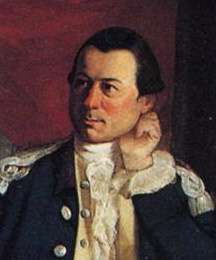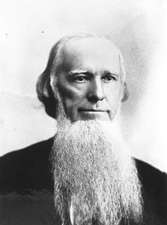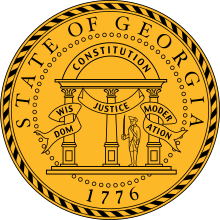Politics of Georgia (U.S. state)
The politics of Georgia change frequently and often follow the rest of the United States in major historical landmarks. The state has a long history, starting in the 18th century as a British colony. The cultural makeup of the early colony led to a ban on slavery being overturned soon after its implementation, setting the stage for the many plantations in the state. Rival governments were formed during the Revolutionary War, with the Patriot government surviving and forming a unified state government after the war. Georgian politics then followed the Democratic-Republican Party before the American Civil War and the Democrats afterward. As the political ideologies of the Democratic and Republican parties shifted in the 20th century, Georgia politicians moved to the Republican Party. This led to Sonny Perdue, elected in 2002, becoming the first Republican governor in the state since 1872.
Colonial times
The Province of Georgia was founded in 1733 as a British colony by a royal charter through a trust led by James Oglethorpe, a member of Parliament who had originally envisioned it as a place to resettle volunteering debtors instead of sending them to prison.[1] It was named after King George II, the reigning monarch of the Kingdom of Great Britain and the Thirteen Colonies at that time. They banned slavery. The province recruited yeomen settlers to occupy land where the native Yamasee had lived before the Yamasee War, acted as a buffer to protect earlier settlements in South Carolina from the Spanish presence in Florida, and hinder West African slaves from escaping and reaching lands beyond the frontier and the control of their owners.
Although most early Georgia colonists were English, Scottish, and German artisans seeking arable land or freedom of religion, many of them complained to their leaders that the ban on slavery created a labor shortage that impeded local finances, compared to other Southern colonies. After Spain failed to conquer the area during the War of Jenkins' Ear, the province legalized slavery in 1749, altering the balance of power in the settlements. Thousands of slaves were imported to work on plantations producing rice, indigo, and sugar. Their owners, mostly South Carolina planters, were wealthier than the early settlers and soon gained most of the official political appointments in the Crown colony that replaced the trusteeship in 1754.
Revolutionary War and Antebellum years

Georgia had two rival governments during the American Revolutionary War: the appointed Loyalist regime of James Wright and the Patriot administration, initially led by planter Archibald Bulloch. After escaping revolutionary forces, Wright fled the colony in 1776 but organized a return in 1778 backed by British military force. After the war, he left again in 1782, evacuating with British forces following the end of hostilities and victory by the rebels. The British also evacuated thousands of slaves to whom they had promised freedom if they left rebel masters. They were resettled in the Caribbean and London.
Bulloch, who died in 1777, and his colleagues founded a republican government. In 1788 Georgia was the fourth state to ratify the new U.S. Constitution.
Georgia had been settled from the along Atlantic Ocean and the Savannah River. The drive of settlers for westward expansion made territorial issues prominent. An expansion from the Altamaha River to the St. Marys River and the drawing of southern and northern borders neglected a western boundary. The colony assumed it would extend to the Pacific Ocean; a nearer limit was the Mississippi River. The federal government worked to reduce such early colonial claims, in the interest of establishing more states. In addition, nationwide anger among the 13 states about the Yazoo land scandal resulted in Georgia leaders defining their claim in 1802 at the Chattahoochee River up to its head of navigation at the site of modern Columbus and a line running north by west from there.
In the early United States, most Georgia politicians were aligned with the Jeffersonian Democratic-Republican Party, favoring strict constructionism in constitutional law and states' rights over federal power. Unlike the Federalist Party, which backed strong central government, Jeffersonians wanted a freer hand in both Indian removal and expanded plantation slavery. Before the Revolution, Georgia was home to the native Creek and Cherokee. The advent of the cotton gin in 1793, which made short-staple cotton profitable in the uplands of the state, and the Georgia Gold Rush in 1829 spurred runs on land. The Georgia Land Lottery tried to reduce corruption by giving native lands to poorer citizens, but did so as native treaties such as the Treaty of Indian Springs (1825) were broken or revised.
By the 1830s, Georgia politics was split by the Jacksonian Democratic Party and the Anti-Jacksonian Whig Party. Congress passed the Indian Removal Act of 1830, favored by Jackson to void Indian land claims in the Southeast and permit development. The U.S. Supreme Court ruled against Georgia's encroachment on other Indian land in Worcester v. Georgia in 1832, on the grounds that Indian natives were entitled to federal protection. But the ruling was ignored by both presidents and the state, and the federal government proceeded to forcibly remove Indians to west of the Mississippi River. The Cherokee were the last to be forced out, led along what they referred to as the Trail of Tears to Indian Territory, during which many people died.
Former Native American lands were developed for cotton cultivation, and planters brought in thousands of slaves to work the new lands. In 1842 the state legislature declared that black people were non-citizens. After the Compromise of 1850 tried to resolve slavery among the states as an issue of balance of power, the Georgia Platform was accepted by many Southerners as the policy by which secession could be avoided.

Civil War years
In the 1850s, most state Whigs joined a reinvented Democratic Party that became inflexible on the issues of supporting the expansion of slavery and a highly devolved federalism. The victory of Abraham Lincoln, who was considered a moderate abolitionist, in the presidential election of 1860 was perceived as a threat to Georgia interests. This large slave society was the fifth state to secede from the Union. A founding member of the Confederate States of America in 1861, the state sent tens of thousands of soldiers to fight in the American Civil War.
Reconstruction through the 20th century
As in other southern states, white conservative Democrats regained control of the state legislature in the 1870s, through a combination of force, intimidation and fraud, with widespread voter suppression of black Republicans. At the turn of the 20th century, Georgia passed a new constitution and amendments that in practice disenfranchised most blacks and many poor whites. The exclusion of blacks from the political system was maintained well into the 1960s.[2][3] The legislature passed laws to institute legal segregation of public facilities and Jim Crow customs governed many informal rules placing blacks in second-class status.
In the postwar era after World War II, African Americans, particularly veterans, renewed their activism for civil rights, including being able to exercise the franchise. Conservative white Democrats formed the States' Rights Democratic Party, splitting from the national Democratic Party. This group—whose members were called Dixicrats—was very segregationist. It pushed for its candidate Strom Thurmond to be the Democratic presidential nominee in southern states. Georgia was the only Deep South state to reject Harry Truman, the national Democratic nominee, as its candidate. Thurmond ran as a third-party candidate in the state.[4]
During the 1960s and 1970s, Georgia made significant changes in civil rights, governance, and economic growth focused on Atlanta. It was a bedrock of the emerging "New South". In 1983, Georgia's tenth Constitution was ratified, and is the newest state constitution in the United States as of 2015.
21st century
In 2002, Sonny Perdue became the first Republican Governor since the Reconstruction.
In 2004, its voters passed a ban on same-sex marriage with 76% voting yes.[5] The ban was invalidated in 2015 by the United States Supreme Court case Obergefell v. Hodges.
About half of all appropriations in the Georgia state budget each year are funded by state taxes, with the remainder of revenue coming from federal grants and state bonds. In recent years, Georgia has had one of the best performing economies of the U.S. states as it relates to both taxation-to-spending and tax-to-debt ratios. It also has the fourth lowest per capita government debt.
See also
- Government of Georgia (U.S. state)
- Elections in Georgia (U.S. state)
- Official Code of Georgia
References
- "Establishing the Georgia Colony - American Memory Timeline- Classroom Presentation | Teacher Resources - Library of Congress". www.loc.gov. Retrieved 2019-12-18.
- Richard M. Valelly, The Two Reconstructions: The Struggle for Black Enfranchisement, University of Chicago Press, 2009
- Michael Perman.Struggle for Mastery: Disfranchisement in the South, 1888–1908. Chapel Hill: North Carolina Press, 2001, Introduction
- Buchanan, Scott (27 July 2004). "Dixiecrats". Retrieved 1 January 2013.
- "Georgia Marriage Amendment, Question 1 (2004)". Ballotpedia. Retrieved 22 May 2010.
